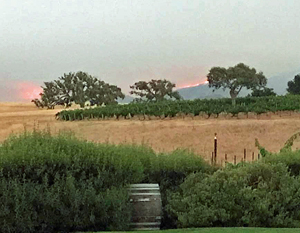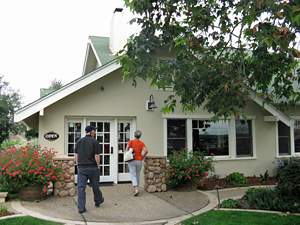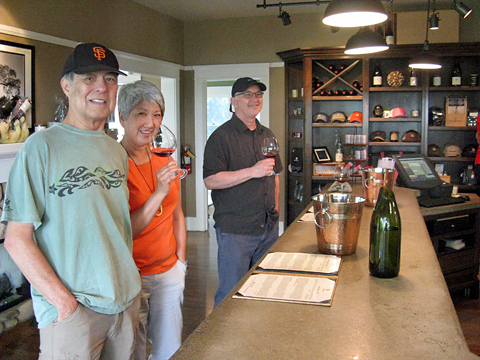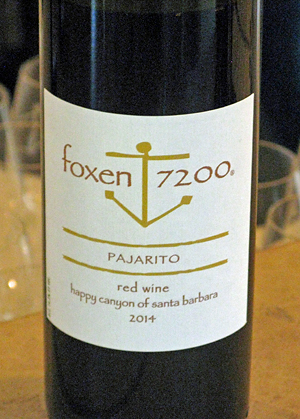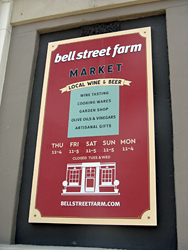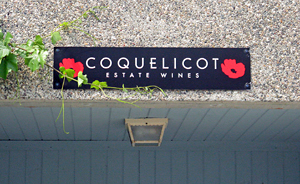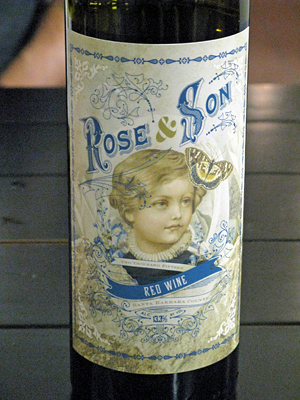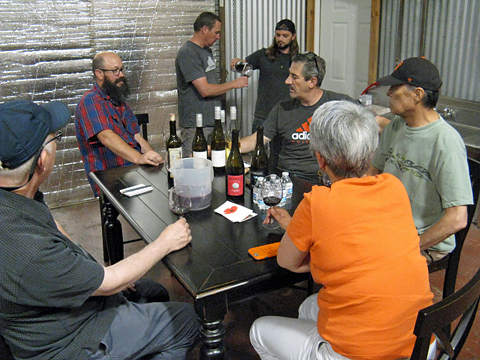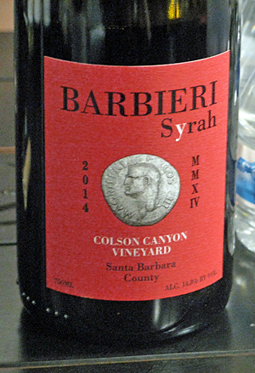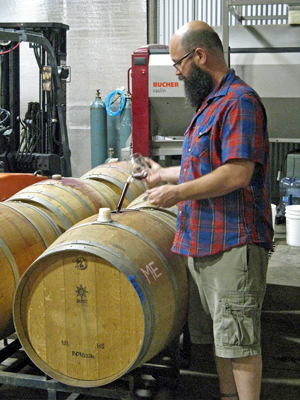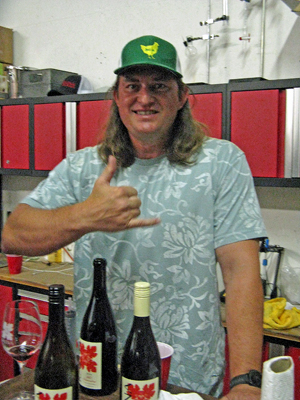Central Coast Tour - July 2017 - Part 3
Although Jane, Chris, Alan, and I had been in Santa Barbara County since Saturday, we had not yet been able to put together a full day of wine-tasting there. We would change all that with a busy Monday in wine country.
On Monday morning we enjoyed leftover flatbread along with coffee for breakfast. We had a full day ahead, with three scheduled winery and tasting room visits plus one other tasting room stop I hoped to make. The wind had apparently changed direction since the previous day and had blown much of the Whittier Fire smoke out of Santa Ynez Valley. The wind coming from the Pacific also helped cool down the temperatures further.
As we drove north into Santa Maria Valley to our first appointment of the day, we encountered much more smoke from the Alamo Fire that had been burning in that area. We’d heard that the fire burned right down to the very edge of famed Bien Nacido Vineyard, and that several winery tasting rooms on the north side of the Sisquoc River were closed due to their proximity to the fire. Our destination was on the south side of the river, and although the sky was smoky, the winery tasting room was open.
|
| The "Whittier Fire" - photo credit: Alan Garretson |
Riverbench Vineyard & Winery
Tasting Notes: Current Releases |
Riverbench 2015 Rosé of Pinot Noir, Santa Maria Valley. Light pink color, with subtle red fruit and hints of flowers. Medium-light weight, with moderate acidity and a fairly smooth finish.
Riverbench 2015 Chardonnay, “Bedrock,” Estate, Santa Maria Valley. Bright, lemony aromas with touches of lees and herbs. Lively texture with a touch of stony minerals on the crisp finish, nice.
Riverbench 2014 Chardonnay, “Reserve,” Santa Maria Valley. This displayed apple and pear fruit along with vanilla/oak, spice, and earth. Bigger and creamier texture than the previous wine, but with good balancing acidity and a long finish.
Riverbench 2014 Pinot Noir, Estate, Santa Maria Valley. Subtle cherry and rhubarb fruit, plus spice, tea leaf, and hints of flowers and earth. Medium weight with nice structure and balance, finishing with fine tannins, nice.
Riverbench 2014 Pinot Noir, “One Palm,” Estate, Santa Maria Valley. More intense aromatics of earth, plum, and spice, with sweet oak undertones. Medium-bodied with more texture and structure than the previous wine, and moderate tannins on the finish, nice.
Riverbench 2014 Pinot Noir, “Mesa,” Estate, Santa Maria Valley. This featured a more red fruit profile than the previous wine, with bright strawberry and cherry along with tea leaf, earth, flowers, and spice. Very pleasant texture on the palate, with good structure and chalky but refined tannins – very nice now and should age well.
|
|
Our first stop of the day was at Riverbench Vineyard & Winery, near the southeastern edge of Santa Maria Valley. I’d been to Riverbench once before, in 2010, so I thought I was past due for a return visit. The winery specializes in estate-grown Chardonnay and Pinot Noir as well as sparkling wines from those varieties. The tasting room and adjacent vineyard are located along Foxen Canyon Road, not far from the small town of Sisquoc. We pulled into the parking lot and walked into the tasting room, located in a beautifully-restored 1920s house. We were greeted there by assistant tasting room manager Elisha Partin. The tasting room has a charming “homey” feel to it, and the picnic tables just outside would make a nice spot to have a picnic lunch – in fact I did just that on my previous visit there.
There are several tasting flight options at Riverbench – including one just for sparkling wines – and we chose some different flights so we could share glasses. As Elisha got us started on our tasting, she told us a little about the background of the vineyard and winery. The original plantings of Chardonnay and Pinot Noir at the vineyard date back to 1973, some of the earlier ones in the area. The current vineyard owners purchased the property in 2004. On a gently sloping site overlooking the Sisquoc River just to the north, the vineyard has mainly sandy alluvial soil, which provides good drainage. There are currently 107 acres of Pinot Noir and 77 acres of Chardonnay planted at the estate site, plus a little Riesling, Viognier, and Pinot Meunier, all farmed sustainably.
Riverbench began making wine under their own label beginning in 2006 – until then, all of the estate fruit was sold to other wineries, and most of it is still sold to other producers. The tasting room opened in 2008, and more recently Riverbench opened a second tasting room in Santa Barbara. 2008 was also the first year that the winery produced a sparkling wine. The Pinot Meunier, which was added to their vineyard in 2015, is expected to become part of their sparkling wine program this year. Clarissa Nagy, who took over as winemaker at Riverbench in late 2011, earned a food science degree from Cal Poly in San Luis Obispo and has worked at a number of noted Central Coast wineries since 1995, including Edna Valley, Byron, Longoria, and Bonaccorsi. She also has her own label, Nagy Wines. The Riverbench wines are made at C2 Cellars in Orcutt, and current production is around 6,000 cases per year. A number of the bottlings are fairly limited, with the most widely-distributed wines being the estate Chardonnay and Pinot Noir, and the “Cork Jumper” Brut Rosé sparkler.
Elisha started me out on the 2015 Rosé of Pinot Noir – this spent about 90 minutes on the skins before being pressed, and was made in neutral French oak. Next was the bright and lemony 2015 “Bedrock” Chardonnay, which was made entirely in stainless steel and went through partial malolactic fermentation. I tasted one more Chardonnay, the 2014 “Reserve” – from clone 4 fruit and made in 50% new French oak, this was in a richer, creamier style.
Elisha moved me along to three Pinot Noirs from the 2014 vintage. The Estate Pinot Noir is considered to be Riverbench’s flagship wine. The fruit for this wine is always sourced from various parts of the vineyard, and the 2014 includes Pommard, 667, and 777 Pinot clones, aged for nine months in 32% new French oak. The more earthy and intense “One Palm” Pinot Noir, from 667 clone, was even better. Fermented with 20% whole clusters this was aged in 64% new French oak barrels. My last wine was the “Mesa” Pinot Noir, sourced from a 4-acre block of some of the estate’s oldest Pinot vines (own-rooted Martini clone) and aged in 60% new French oak. Three very good Santa Maria Valley Pinots – each quite distinctive and all showing good typicity of the region’s character.
I didn’t taste the Riverbench sparkling wines on this visit (though Chris went through the sparkling flight at the tasting room), but the winery makes several bottlings including a Blanc de Blancs, Blanc de Noirs, Brut Rosé, and a Blanc de Blancs Demi-Sec. There were a few other Chardonnays and Pinots that I didn’t try – the Estate and “Chapel View” Chardonnays as well as “Tributary”, “Reserve”, and “Pommard” Pinot Noirs. Riverbench also makes a small amount of off-dry Riesling, plus a sweet late harvest version.
Our visit to Riverbench was enjoyable. The tasting room has a relaxed atmosphere and Elisha did a fine job of guiding us through the winery’s current releases. I liked the 2015 “Bedrock” Chardonnay quite a bit (and it’s a very good value), but overall I felt the Pinot Noirs were the stars at Riverbench. All three that I tasted were very good – the 2014 Estate bottling is a terrific value for a fine Santa Maria Valley Pinot, and the 2014 “One Palm” and 2014 “Mesa” Pinots were a step up in complexity and showed distinctive character. While a touch of oak is noticeable in the Pinot Noirs, it’s kept in balance deftly. Riverbench wines don’t get a lot of hype – perhaps because the overall style is not especially edgy or trendy – but the line-up presents an especially well-considered group of fine Santa Maria Valley Chardonnays and Pinots that represent the region nicely.
Foxen Winery & Vineyard / Foxen 7200
Tasting Notes: Current Releases |
Foxen 2016 Rosé of Mourvèdre, Santa Ynez Valley. Subtle black cherry fruit with touches of flowers and earth. Medium-light weight with good acidity and a lively finish.
Foxen 7200 2016 “Volpino Rosato,” Santa Ynez Valley. From Sangiovese and Merlot. Bright red fruit, herbs, and a hint of spice on the nose. Juicy acidity with a clean, fresh finish, nice.
Foxen 7200 2015 Sauvignon Blanc, Vogelzang Vineyard, Happy Canyon of Santa Barbara. Bright citrus and melon aromas along with herb and floral notes in the background. Medium-light bodied with a crisp finish.
Foxen 2014 Chenin Blanc, “Old Vines,” Ernesto Wickenden Vineyard, Santa Maria Valley. Pear, stone fruit, and spice aromas. Medium-bodied with a mildly creamy texture and lively finish.
Foxen 2015 Chardonnay “Block UU,” Bien Nacido Vineyard, Santa Maria Valley. Pear and apple notes along with vanilla/oak and spice. Moderately rich mouthfeel with a chalky mineral note on the finish.
Foxen 2014 Pinot Noir, Sta. Rita Hills. This featured smoky and spice aromas along with earthy notes and a darker berry fruit profile. Medium weight with good structure and fine tannins.
Foxen 2013 Pinot Noir, La Encantada Vineyard, Sta. Rita Hills. Spice and sour cherry on the nose, along with a dash of sweet oak. Medium-bodied with a slightly tangy finish.
Foxen 2014 Pinot Noir, John Sebastiano Vineyard, Sta. Rita Hills. More intense aromas of black cherry and plum fruit, earth, and lots of spice. Bolder mouthfeel than the previous Pinots, with a more structured texture and finish, nice.
Foxen 2014 Pinot Noir, Melville Vineyard, Sta. Rita Hills. Bright black cherry, with hints of herbs and earth. Medium weight with good acidity and refined tannins.
Foxen 2013 Pinot Noir, Fe Ciega Vineyard, Sta. Rita Hills. Earthy black cherry, tea leaf, flowers, and spice on the nose. Great texture and fine structure for further aging, with chalky tannins on the finish, nice.
Foxen 7200 2015 “Range 30 West,” Happy Canyon of Santa Barbara. 54% Merlot, 46% Cabernet Franc. Plum and darker fruit, with smoke and dried herb notes and a touch of sweet oak. Medium-bodied with good structure and fine tannins, nice.
Foxen 7200 2015 “Pajarito,” Happy Canyon of Santa Barbara. 50% each Merlot and Petit Verdot. Tobacco/dried herbs upfront, with spice and darker berry fruit in support. Medium-full bodied with lively acidity and moderate tannins, nice.
Foxen 7200 2013 Cabernet Sauvignon, Vogelzang Vineyard, Happy Canyon of Santa Barbara. 100% Cabernet Sauvignon. Plum and currant, spice, and dried herb aromas. Medium weight, with a moderately grippy finish.
Foxen 7200 2013 “Guillermo Grosso,” Santa Ynez Valley. 62% Sangiovese, 38% Cabernet Sauvignon. This featured black cherry and plum, earth, spice, and herbs on the nose. Bolder structure with great acidity and firm tannins, nice.
Foxen 2013 Syrah, Tinaquaic Vineyard, Santa Maria Valley. 96% Syrah, 4% Viognier. Raspberry, smoke, vanilla/oak, and herbs, with touches of earth and spice. Big and structured, with somewhat chewy tannins on the finish.
Foxen 2013 Syrah, Williamson-Doré Vineyard, Santa Ynez Valley. This displayed more herb and black olive character than the previous wine, with plum and darker fruit, and hints of flowers and pepper. Brighter texture on the palate with plenty of structure and tannins, nice though it could use more cellaring to mellow out.
Foxen 2010 Mission, Barberena Vineyard, Santa Maria Valley. 10% residual sugar. Ripe plum/prune with touches of brown sugar and spice. Moderate acidity and sweetness with a long finish.
|
|
Foxen Canyon Road is one of my favorite drives in Santa Barbara wine country, and it’s tough for me to head down that road without stopping at Foxen Winery. We hadn’t made an appointment there but figured we could stop in for a quick tasting before lunch. Foxen was one of the first Santa Barbara County wineries I visited when I started coming to the area in the early 1990s, and it’s remained a favorite over the years. They feature a wide selection of different wines – not only Chardonnay and Pinot Noir but also wines from Bordeaux, Rhône, and Italian grape varieties among others. We stopped across the road from the iconic old Foxen tasting room (the “shack,” a former blacksmith shop that dates from the 1860s) but it looked like it was closed. Sure enough, there was a sign on the door noting that it was closed due to poor air quality with so much smoke from the fires in the area – when the small tasting room is open, the doors are wide open to the outside. The good news was that all the Foxen wines were being poured that day at their newer tasting room just up the road, so we headed over there and arrived just a couple of minutes later, right at their opening time.
Bill Wathen and Dick Doré founded the winery in 1985. It’s named in honor of William Benjamin Foxen, Dick’s great-great-grandfather – in 1837 Foxen purchased Rancho Tinaquaic in the scenic canyon that now bears his name. Dick was raised on the Rancho Tinaquaic land, and met Bill in the late 1970s while working at Tepusquet Mesa Vineyard. Bill had been the vineyard manager at Chalone Vineyard, where he worked with winery founder Dick Graff. Operating for years in the increasingly cramped space of their original facility, Foxen opened their new solar-powered winery in time for the 2010 crush. David Whitehair came on board in 2008 as assistant winemaker, and he was promoted to winemaker for Foxen in 2016.
Foxen’s ten-acre estate Tinaquaic Vineyard is located in Foxen Canyon not far from the winery. Bill and Dick planted it in 1989, and it’s the only vineyard in the area that is dry-farmed. It’s planted mainly to Chardonnay, along with some Syrah and Cabernet Franc, all of which is own-rooted. Another key source of fruit is the seven-acre Williamson-Doré Vineyard in the Santa Ynez Valley, owned by Dick and his wife Jenny. This is planted to Syrah, Grenache, Mourvèdre, and Sangiovese. Foxen sources most of its fruit from other vineyards throughout Santa Barbara County, from the cool Santa Maria Valley and Sta. Rita Hills to warmer Santa Ynez Valley and Happy Canyon.
As noted above, Foxen now operates two tasting rooms that are within a short distance of each other. The newer one – where we’d just arrived – is adjacent to their new winery building and was opened in 2009, while the original tasting room at the “shack” is still in use as well. Different wines are typically poured at each place – the old tasting room focuses on the “Foxen 7200” line, which includes the winery’s Bordeaux-style and Cal-Ital bottlings, while the new tasting room pours their Chenin Blanc, Chardonnay, Pinot Noir, and Rhône-style wines.
Micaela Buchanan opened the doors of the tasting room for us – the first group of tasters for the day! Since she had both the Foxen and Foxen 7200 wines available for tasting there, we found there were several options for tasting flights. As we’d done at our previous winery stop, we chose different flights among ourselves and shared many of the wines – in this case, that meant a lot of wines between us. It sometimes got a little confusing and I wound up doing more “speed tasting” than I normally like to do – which explains why most of my wine tasting notes for Foxen are pretty short – but I did my best!
Sampling from three tasting flights meant that I was able to try a broader range of wines than I would typically do here, and I got a great overview of the entire Foxen line-up this way. I started out with a nice 2016 Mourvèdre Rosé, left on the skins for a day before pressing and then made in neutral oak. Even better was the 2016 “Volpino Rosato” – made in a similar way, this came from Sangiovese and Merlot grapes. 2015 Vogelzang Vineyard Sauvignon Blanc, 2014 “Old Vines” Ernesto Wickenden Vineyard Chenin Blanc (Foxen is now on to the 2015 vintage of this wine), and 2015 “Block UU” Bien Nacido Chardonnay followed. Foxen’s Chenin Blanc is a consistent winner, from 50-year old vines, whole-cluster pressed, and aged in neutral oak. The barrel-fermented Chardonnay (20% new French oak) is in a richer style and deserves some aging to show its best.
Between the different tasting flights, I tried five Pinot Noirs from Sta. Rita Hills, four of them single-vineyard designates – 2014 Sta. Rita Hills appellation blend (from John Sebastiano and La Encantada vineyards), plus 2013 La Encantada Vineyard, 2014 John Sebastiano Vineyard, 2014 Melville Vineyard, and 2013 Fe Ciega Vineyard bottlings. Fruit for the Pinots is entirely destemmed but not crushed, and the wines are all in barrel for 17 months. Micaela told us that the single-vineyard wines typically are aged in 30-50% new French oak, with François Frères and Taransaud being two of the favored cooperages. This was the first Foxen Pinot I’d tasted from Rick Longoria’s Fe Ciega Vineyard – I didn’t even realize they made one from there – and it was a particular favorite, though this vintage is now sold out.
We changed course with three Bordeaux-style wines – the 2015 “Range 30 West” Merlot / Cabernet Franc blend, 2015 “Pajarito” Merlot/Petit Verdot blend (both wines with fruit mostly from Vogelzang Vineyard in Happy Canyon), and 2013 Vogelzang Vineyard Cabernet Sauvignon. I followed this with the 2013 “Guillermo Grosso” Super Tuscan style blend, with Sangiovese from Faith Vineyard in Los Olivos and Cabernet Sauvignon from Vogelzang Vineyard. All very good wines, with the “Pajarito” being a particular standout and the “Guillermo Grosso” not far behind.
I finished my tasting at Foxen with a pair of 2013 Syrahs, from Tinaquaic Vineyard (with 4% Viognier) and from Williamson-Doré Vineyard. Fruit for both was entirely destemmed, and aged in about 40% new French and Hungarian oak for 20 months. Both were big but balanced, and I preferred the more herbal and black olive character of the Williamson-Doré bottling.
Before I left, I asked Micaela about Foxen’s Mission dessert wine, as this was of particular interest to me since I recently made a similar wine myself. Although their most recent vintage was already sold out, I was able to pick up a bottle of 2010 Mission library wine that I tasted later. The fruit was sourced from Barberena Vineyard in Tepusquet Canyon, from a ¼ acre block of Mission vines that Foxen manages there.
Other Foxen wines I didn’t taste on this visit included Sauvignon Blanc, another Chardonnay, several more Pinot Noirs, “Cuvée Jeanne Marie” (Grenache/Mourvèdre blend), another Syrah, Sangiovese, “Volpino” (Sangiovese/Merlot blend), two more Cabernet Sauvignon bottlings, Cabernet Franc from Tinaquaic Vineyard (a longtime favorite), and “Sweet Ending” (Viognier/Sauvignon Blanc dessert wine).
Foxen continues to do a fine job with many different grape varieties and blends. From Burgundy to Bordeaux to Rhône to Italian varieties, they’re all handled well. Micaela was a terrific host to our group, and it turned out to our advantage that their other tasting room was closed that day so that we could taste both the Foxen and Foxen 7200 wines at the same time. Having tasted quite a few wines, I had quite a few favorites. These included the 2016 “Volpino Rosato,” 2014 John Sebastiano Vineyard Pinot Noir, 2013 Fe Ciega Vineyard Pinot Noir, 2015 “Range 30 West,” 2013 “Guillermo Grosso,” and 2013 Williamson-Doré Vineyard Syrah. There are few if any other producers in Santa Barbara County that succeed at such a broad range of wines as Foxen does, and it’s still a “must” stop for me when I’m in the area.
I’d been to Bell Street Farm in Los Alamos once before and thought that would be a good choice for lunch, especially since it was right on our way back to Buellton, where we were headed next. Bell Street owner Jamie Gluck was on hand and he seemed to know nearly everyone who came in to eat when we were there. He has a way of making everyone feel at home and in good spirits. I had “The Italian Melt” sandwich – hot and sweet salami, mortadella, provolone, arugula, house-pickled peppers and pasilla chile, mayo and whole grain mustard on ciabatta – wow! Really delicious, and everyone else’s lunch dishes looked and smelled just as good. This will become a regular stop for me from now on.
Our first afternoon appointment was supposed to be with Mikael Sigouin of Kaena Wine Company but there was a last-minute glitch with Mikael’s schedule and he needed to hold off until later in the afternoon to see us. Fortunately I was able to get in touch with Mike Roth of Coquelicot, who we were scheduled to visit later, and it worked out perfectly to flip-flop the two afternoon appointments.
Coquelicot Estate Vineyard / Barbieri Wine Company / Lo-Fi Wines
Tasting Notes: Current Releases & Barrel Samples |
Coquelicot 2015 Riesling, Estate, Santa Ynez Valley. Bright aromas of apple, citrus, flowers, and a touch of petrol. Medium-light bodied with vibrant acidity and long, clean finish, nice.
Coquelicot 2016 Riesling, Estate, Los Olivos District. This had pear and stone fruit on the nose with hints of flowers and petrol. More viscous than the previous vintage but with plenty of acidity, and a slightly sweet finish.
Coquelicot 2015 Sauvignon Blanc, Estate, Santa Ynez Valley. Floral and grapefruit aromas along with background notes of fresh herbs and earth. Medium-light weight with lively acidity and finish, nice.
Coquelicot 2016 Chardonnay, Estate, Los Olivos District. Displaying apple, lees, and spice, with earthy and nutty undertones. Medium-bodied with bright acidity and a long finish.
Coquelicot 2016 Rosé, Estate, Los Olivos District. From 100% Sangiovese. Fresh strawberry aromas along with herbs and earth. Medium-light weight with fine acidity and a slightly chalky mineral note on the finish, nice.
Coquelicot 2015 “Rose & Son” Red Wine, Estate, Santa Barbara County. 28% Merlot, 28% Sangiovese, 22% Cabernet Sauvignon, 11% Carménère, 6% Malbec, 5% Petit Verdot. This featured plum and darker berry fruit, spice, earth, and a touch of sweet oak on the nose. Medium-bodied with good structure and moderate tannins.
Coquelicot 2016 Merlot, Estate, Los Olivos District (barrel sample, lot 1). Upfront black cherry aromas plus earth and loads of spice, medium-bodied with a lively texture and finish.
Coquelicot 2016 Merlot, Estate, Los Olivos District (barrel sample, lot 2). Darker color than the previous wine, with a less fruit-forward profile – more earth and mushroom notes, quite distinctive.
Barbieri 2014 Syrah, Colson Canyon Vineyard, Santa Barbara County. Aromas of ripe dark berry fruit, coffee, and spice. Moderately rich texture balanced by bright acidity, with firm tannins on the finish.
Barbieri 2014 “Romanus,” Santa Barbara County. 95% Syrah, 5% co-fermented Viognier. Blackberry, spice, and black olives on the nose, with hints of flowers and sweet oak. Richer mouthfeel with great structure and grippy tannins – deserves time in the cellar but has lots of promise, nice.
Barbieri 2015 “Dromeus,” Central Coast. 100% Grenache. This was plummy and floral, with earth and spice notes in support. Fairly big and ripe, with a chalky tannic finish – needs time.
Coquelicot 2016 “Mon Amour,” Estate, Los Olivos District (barrel sample). 20% each Cabernet Sauvignon, Cabernet Franc, Merlot, Malbec, Petit Verdot. Bright plum and black cherry fruit along with earth and dried herbs on the nose, with a moderately rich texture with lively acidity and firm tannins.
Lo-Fi 2014 Malbec, Coquelicot Vineyard, Los Olivos District (barrel sample). Dark fruit with spice and floral undertones, big and structured with a grippy tannic finish – needs time but good potential.
Lo-Fi 2016 Pinot Noir, Kick-On Ranch, Santa Barbara County (barrel sample). Herbal/stemmy aromas with spice and red fruit in the background, lively texture with moderate tannins, needs time to develop.
Barbieri 2016 Pinot Noir, Kick-On Ranch, Santa Barbara County (barrel sample). More upfront fruit than the previous wine but still a noticeable herb/tea leaf component and a touch of tomato leaf.
Lo-Fi 2016 Cabernet Franc, Coquelicot Vineyard, Santa Ynez Valley (barrel sample 1). Bright cherry and plum aromas with flowers, herbs, and spice notes, juicy acidity and milder tannins, nice.
Lo-Fi 2016 Cabernet Franc, Coquelicot Vineyard, Santa Ynez Valley (barrel sample 2). Similar aromatics to the previous wine, with a distinctive orangepeel component..
|
|
After reversing the order of our Monday afternoon appointments, we headed to Buellton to taste the wines of Coquelicot Estate Vineyard with winemaker Mike Roth. I’d visited Mike most recently in early 2015, when I tasted his Lo-Fi wines with him and his business partner Craig Winchester at their warehouse winery space in Buellton. Since that time, Mike has also taken over the winemaking duties for Coquelicot Estate Vineyard. I’d heard about the vineyard before – Lo-Fi among others source fruit from there – but I’d never tried the Coquelicot wines, so I thought this would be a good chance to do that.
Mike had moved into a different winemaking space not long after my last visit with him, but it’s just a couple of hundred feet farther down the same street, among a group of warehouse buildings not far from the freeway in Buellton. Mike welcomed us into the large open space, and introduced us to his nephew Sean Hogan, who has been assisting him with the winemaking for about three years. I’d first met Mike in spring 2007 when he was the winemaker at Demetria, off of Foxen Canyon Road in northern Santa Ynez Valley. Mike got his start at various Napa wineries including Grgich Hills and Saddleback. After earning an enology degree from Cal State Fresno, he returned to Napa for awhile before heading to Santa Barbara County, where he became the winemaker at Koehler, moving on to Demetria in 2005 and then to Martian Ranch in 2011 before founding Lo-Fi with old college buddy Craig in 2013.
Mike took over the winemaking at Coquelicot from Michael Larner in 2015. The winery name looks like more of a tongue-twister than it really is – just think “Ko-klee-ko.” The vineyard, not far from the Santa Ynez River just east of Solvang, was first planted in 1998. Current owner Bernard Rosenson purchased the property in 2005. His childhood growing up in France, and his work in the restaurant and hospitality business – he was behind restoring and reviving the noted Breakers Hotel and its Sky Room Restaurant in Long Beach – led him to a love of wine. He wanted to farm organically, and the 52-acre vineyard was certified organic in 2010. The vineyard currently includes 14 varieties: Grüner Veltliner, Riesling, Sauvignon Blanc, Sylvaner, Chardonnay, Chenin Blanc, Sangiovese, Cabernet Sauvignon, Cabernet Franc, Merlot, Petit Verdot, Malbec, Carménère, and Syrah. All of the Coquelicot wines are made with estate fruit, though most of the vineyard’s fruit goes to about a dozen other local producers. Mike told me that the winery itself is in the process of organic certification too. Since Mike has been making the wines there, they’ve all been made using native fermentations, aged in older oak, stainless steel, and other neutral vessels, and Mike has been making a few wines with no added sulfur as well.
Jane, Chris, Alan, and I all sat around a table with Mike and Sean, and Mike started pouring us some of the current Coquelicot releases. We started out with two vintages of Riesling, from 2015 and 2016. They were quite different, with the 2016 having noticeably higher residual sugar than the 2015. Mike ferments these at lower temperatures and he just lets them go as far as they’ll go, without doing anything special to push them toward going dryer. It’s inevitable that there will be vintage variation such as with these two wines, and different people in our group preferred one or the other of the two vintages. Mike told us that he’s working on an Austrian-style blend of Grüner Veltliner, Riesling, Sauvignon Blanc, and Sylvaner to be bottled in one-liter bottle with a crown cap closure.
We followed the Rieslings with a citrusy and floral 2015 Sauvignon Blanc – this came from both clone 1 and Musqué clone fruit, and was made in tank and neutral oak. Next was 2016 Chardonnay, all barrel-fermented with full malolactic fermentation. The 2016 Rosé is from early-picked direct-press Sangiovese fruit – very fresh and bright. Our final bottled Coquelicot wine was the 2015 “Rose & Son” blend of mostly Bordeaux grape varieties. The name of the wine is a play on the owner’s name (Rosenson), and it’s the first of Mike’s Coquelicot reds that he’s bottled there. He told us that the Cabernet Sauvignon and Merlot get about 45-day extended maceration, and that this wine was aged in newer oak than Mike prefers since he needed to use newer barrels left over from before he took over the winemaking.
Mike led us over to the stacks of barrels in the winery, where he pulled two 2016 Merlot samples, one made with extended maceration and one without – quite different from one another and I preferred the extended maceration sample. It was just about this time when Mike’s Lo-Fi partner Craig Winchester walked in along with fellow vintner Paolo Barbieri, who shares the winery space with them. As we still had some time before our next appointment, Mike asked Paolo if he would like to open a few of his wines for us. This was an unexpected bonus, and a good chance to learn about another small local producer.
Paolo was born in Parma, Italy and began working in the restaurant business in England before moving to the US. He worked as wine director at some of Las Vegas’ finest restaurants, including Alex at the Wynn Resort and at Le Cirque and Circo at Bellagio, and passed the notoriously difficult Master Sommelier exam in 2003. He developed a particular love of Rhône-variety wines, and they are the main focus of his Barbieri label, which he launched in 2005. The inaugural Barbieri wine was a Syrah from Colson Canyon Vineyard.
Paolo opened three bottles for us. The 2014 Colson Canyon Vineyard Syrah was made from 7 and 877 Syrah clones. As we tasted the wine Paolo expressed concern about the vineyard – owned by his friend Joey Tensley – as it’s located in Tepusquet Canyon very close to where the large Alamo Fire had been burning, but fortunately we learned later that the vineyard was unscathed by the fire. The next wine was the 2014 “Romanus” Syrah, with fruit from Colson Canyon and from Fess Parker Rodney’s Block, plus 5% co-fermented Viognier. We tasted one more bottled Barbieri wine, 2015 “Dromeus” Grenache – sourced from 60% Seven Oxen Vineyard in the Paso Robles area and 40% from Colson Canyon. The black olive and spice aromas of the “Romanus” made it my favorite of the three.
As we still had a bit more time, Mike went back to pulling barrel samples for us to taste, starting with 2015 Coquelicot “Mon Amour” – a blend of equal parts Cabernet Sauvignon, Cabernet Franc, Merlot, Malbec, and Petit Verdot that was to be bottled the following day. We moved on to a few of Mike and Craig’s Lo-Fi Wines barrel samples, plus one of Paolo’s for comparison. The dark-fruited and floral 2015 Lo-Fi Malbec, fermented with foot-stomped whole clusters, was just 11.2% alcohol, and Mike said it would be bottled soon after our visit. We compared 2016 barrel samples of Lo-Fi and Barbieri Pinot Noir from Kick-On Ranch. Lo-Fi’s version was fermented entirely with whole clusters, while Barbieri’s is 35% whole-cluster – not surprisingly, quite different from one another, and I think it will take more time for each to show their best.
Our final wine was a barrel sample of 2016 Lo-Fi Cabernet Franc from Coquelicot Vineyard, made with 18 days of carbonic maceration, with the CO2 pumped in from a tank of fermenting Chardonnay. We actually tasted samples from two barrels of this wine – Mike told us before we tasted them that he was concerned that the wine in the second barrel had picked up an especially bitter note, but it actually had more of a distinctive orangepeel character, slightly bitter but not unpleasant. Needless to say, Mike was pleased that this barrel seemed to be coming around!
Coquelicot is still phasing in the wines that Mike has made for them – particularly their new reds – and he told us that some of their previous bottlings will be phased out or transformed.
It’s easy to have a good time when visiting Mike at the winery. He always seems to have a smile on his face, and of course it doesn’t hurt that he makes some very good wines, both for Coquelicot and for his own Lo-Fi label. And this is the second visit in a row when Mike has been super-generous in introducing my friends and me to other winemakers with whom I was completely unfamiliar, and having us taste their wines as well as his. Paolo’s Barbieri wines are quite different than Mike’s – they’re bigger and generally more fruit-forward – and the 2014 “Romanus” was my favorite of the Barbieri wines. Of the Lo-Fi barrel samples we tried, I thought the 2014 Malbec and 2016 Cabernet Franc showed the most promise. And among the Coquelicot wines, the 2015 Riesling, 2015 Sauvignon Blanc, and 2016 Rosé were my favorites, with the 2016 Chardonnay and 2015 “Rose & Son” blend not far behind. Stylistically, the Coquelicot wines are similar to wines Mike has made at Lo-Fi – maybe not quite as “edgy” but still on the higher-acid and lower-alcohol side of the winemaking spectrum and avoiding the use of new oak. For fans of this style (and really anyone else too!), a stop at the Coquelicot tasting room right near the center of Los Olivos should be on your wine-tasting itinerary.
Kaena Wine Company
Tasting Notes: Current Releases & Barrel Samples |
Kaena 2016 Nebbiolo, Estelle Vineyard, Los Olivos District (barrel sample). Floral, spice, and earth aromas along with cherry and a touch of stone fruit, medium weight with a big tannic finish.
Kaena 2016 Grenache, Lieff Ranch, San Luis Obispo County (barrel sample). Lots of spice and herb notes with red fruits, plenty of structure with grippy tannins.
Kaena 2014 Grenache, Santa Ynez Valley. Upfront and slightly higher-toned red fruit, with herbs and a touch of pepper in the background. Medium-bodied with moderate tannins.
Kaena 2014 Grenache, Tierra Alta Vineyard, Ballard Canyon. This had spice aromas leading the way, followed by ripe strawberry and earth. A bit bigger texture on the palate than the previous wine, with fine tannins on the finish, nice.
Kaena 2015 Grenache, La Presa Vineyard, Los Olivos District. Showing plenty of cherry fruit and spice, plus notes of flowers and earth on the nose. Medium weight with moderate tannins.
Kaena 2014 Grenache, “Clone 513,” Tierra Alta Vineyard, Ballard Canyon. This displayed a more savory, herbal character, along with bright red fruit and a hint of flowers. Medium-bodied with chalky but refined tannins, nice.
Kaena 2014 Grenache, “Clone 362,” Tierra Alta Vineyard, Ballard Canyon. Darker fruit profile, with plum, earth, and spice. Bigger texture with more structure and a grippier tannic finish – needs time.
Kaena 2014 Grenache, “Ali’i,” Tierra Alta Vineyard, Santa Ynez Valley. This was less fruit-forward than most of the other Grenache bottlings, with a more savory profile along with red fruit and spice. Medium-bodied with good structure and firm tannins – a young wine with lots of promise that should benefit from time in the cellar.
Kaena 2014 “Hapa,” Santa Ynez Valley. 36% Syrah, 22% Cabernet Sauvignon, 16% Malbec, 16% Grenache, 10% Petit Verdot. Aromas of tobacco/dried herb upfront plus spice, earth, and darker berry fruit. Somewhat richer texture with moderate tannins on the finish.
Kaena 2013 Syrah, Tierra Alta Vineyard, Ballard Canyon. Meaty and savory aromas with blackberry, coffee and spice notes. Medium-full bodied, with firm but refined tannins, nice.
Kaena 2016 Cabernet Sauvignon / Petit Verdot, Stag Canyon Vineyard, Los Olivos District (barrel sample). Intense ripe currant and plum aromas with tobacco/dried herb, earth, and spice, with plenty of structure.
Kaena 2016 Cabernet Sauvignon / Petit Verdot, Stag Canyon Vineyard, Los Olivos District (barrel sample). This showed a darker fruit profile than the previous wine along with chocolate/mocha notes.
Kaena 2016 Grenache Rosé, Santa Ynez Valley. Bright floral aromas along with tropical fruit notes and a touch of spice. Lively mouthfeel and a clean finish, nice.
Kaena 2016 Albariño, Santa Ynez Valley. This featured pretty floral aromatics with apple and citrus fruit, spice, and a slightly saline component. Vibrant acidity with a long, crisp finish, nice.
Kaena 2016 Sauvignon Blanc, La Presa Vineyard, Los Olivos District. Grapefruit, flowers, and fresh herbs on the nose. Medium-light bodied with a lively texture and finish.
Kaena 2015 “Hapa Blanc,” Santa Ynez Valley. 45% Roussanne, 22% Grenache Blanc, 11% Viognier, 11% Riesling, 11% Albariño. Aromas of ripe stone fruit, pear, spice, and flowers, with undertones of earth. Richer texture with a slightly chalky finish – could be a good candidate for aging.
Kaena 2015 Roussanne, La Presa Vineyard, Los Olivos District (barrel sample). Apple skin and honey on the nose along with spice and earth, moderately rich texture and a lively finish, good potential.
|
|
As we were finishing up our early-afternoon tasting, we got word from Mikael Sigouin of Kaena Wine Company that he’d arrived back at his winery and was ready to see us. It was just a short distance from where we were so most of us walked up to his place, where he was outside waiting to greet us. I first met Mikael about 15 years ago when he was working at the Beckmen tasting room. While I’d seen him several times since then, it had been quite awhile since I’d tasted with him. I happened to bump into him a couple of years ago at the Buellton Bodegas custom crush facility and realized I was long past due for a visit. Since then, he moved from that facility to his own space right next door. Mikael is known far and wide as the “Grenache King,” and we would soon get a demonstration of why that name is appropriate!
Mikael grew up in Honolulu, and he’s part Hawaiian. After moving to the mainland in the mid-1990s, he started working for Beckmen Vineyards during their 1999 harvest. After a few years there, he moved to Fess Parker Winery, returning to Beckmen in 2006 where he become the head winemaker. He left Beckmen in 2014 to focus entirely on his own Kaena label. Mikael started Kaena back in 2001 with a Syrah, and he has worked mainly with Rhône grape varieties over the years – Grenache in particular. The name Kaena comes from his great-grandmother, whom Mikael credits as his biggest influence. She called him “Ka’ena’ai,” meaning “potential for greatness.” For short, she would also call him “Kaena,” which means “proud” – and Mikael is certainly proud of both his heritage and his wines.
Mikael works with quite a few grape varieties these days, and makes a lot of different bottlings, with a total annual production of around 5,000 cases. Wines are bottled with both cork and screwcap closures, with lower-priced bottlings generally getting screwcaps. Mikael makes no fewer than ten different bottlings of Grenache, including Blanc and Rosé, though not including Grenache blends – we were able to taste seven Kaena Grenaches on this visit. The distinctive Kaena logo on the wine labels is made up of four grapeleaves forming a design that’s reminiscent of a Hawaiian floral pattern. Mikael is known for working with fruit from two of the top vineyards in Ballard Canyon, Tierra Alta and Larner. Each of those two vineyards has a different soil type, with Tierra Alta being clay with limestone subsoil, and Larner – a few miles to the south – being sandy soil. Each site produces different and distinctive fruit. He also works with several noted vineyards in the new Los Olivos District of Santa Ynez Valley, such as La Presa and Camp 4. He’s branched out to a few other fruit sources in recent years as well.
Mikael started out our tasting with a couple of 2016 barrel samples. First was a Nebbiolo, from Estelle Vineyard in the Los Olivos District – the first time I’d heard that Mikael was working with that variety. Next we sampled a Grenache from Lieff Ranch – it’s located near Highway 166 in southern San Luis Obispo County and has head-trained Alban clone Grenache vines. We moved on from there to taste six different red Grenache bottlings – Mikael couldn’t find a bottle of his Larner Vineyard Grenache to open or it would have been seven! Why is he so hooked on Grenache? He’s said that he’s drawn to the intense aromatics, bold yet feminine. He’s also noted that it can be a difficult grape variety to work with but the wines can offer great reward.
Mikael told us that he usually completely destems the Grenache fruit from Larner Vineyard but generally includes about 30% stems when fermenting the Tierra Alta Grenache. Mikael does native fermentations for all his reds (he does inoculate for whites), and presses Grenache shortly before it goes dry and lets it finish in tank before racking it to barrel, where he usually does some lees-stirring. He presses a bit earlier for Syrah (at about 2-5 brix), to help manage the tannins. Grenaches are aged in barrels that are three years old or older, and he uses little new oak on Syrahs. Whites are made in stainless steel or neutral oak. Mikael does most of his blending shortly before bottling.
Mikael proceeded to open one Grenache after another for us, and considering the relatively small number of vineyards he sources the fruit from, it was remarkable how distinctive they were from one another. The 2014 Santa Ynez Valley appellation Grenache was sourced from the lower part of Tierra Alta Vineyard, mostly from Tablas A clone plus some 513 and 362 clones. A bit bigger and spicier was the 2014 Tierra Alta Grenache, all from Tablas clone. The 2015 La Presa Vineyard Grenache featured somewhat darker fruit plus a floral note, while the 2014 Tierra Alta “Clone 513” Grenache – Mikael noted this clone has larger berries – was more savory and herbal. We also tasted the 2014 Tierra Alta “Clone 362” Grenache, which was darker and grippier. Our last Grenache was the 2014 “Ali’i” (Hawaiian for chief or noble) bottling. Mikael noted he’d tried blending Grenache from Larner and Tierra Alta vineyards but found they didn’t work well together, but blending both with fruit from La Presa Vineyard worked – “Ali’i” is about 1/3 from each vineyard.
Following our Grenache-athon, we tasted the 2014 “Hapa” – a blend of Syrah, Cabernet Sauvignon, Malbec, Grenache, and Petit Verdot, aged in about 36% new oak. The Rhône varieties came from Tierra Alta Vineyard, while the Bordeaux varieties were from Stag Canyon Vineyard in the Los Olivos District. Next was the meaty, savory 2013 Tierra Alta Syrah. Mikael told us that this is from Clone 1 (“Hermitage clone”) Syrah – the vines were grown from cuttings that had been cleaned up at Davis after coming from Australia, where they’d been planted in the 1860s. Our final red wines were barrel samples, comparing two barrels of a 2016 Cabernet Sauvignon / Petit Verdot co-ferment (about 67% Cab) from Stag Canyon – one sample from a new Mercurey 300-liter barrel and one from a new A.P. John barrique.
We finished our tasting with a rosé and several white wines. Although Kaena is known for Grenache, white wines make up nearly half of the total production. The bright and floral 2016 Grenache Rosé was made from six lots from four vineyards, and includes a little Syrah as well as about 28% Grenache Gris. Mikael told us that the 2016 Albariño is one of his favorites, and it was easy to see why. Sourced from Brick Barn Vineyard in the Buellton area, this had beautiful aromatics and a crisp finish. 2016 Sauvignon Blanc from La Presa Vineyard was next, followed by the 2015 “Hapa Blanc,” a blend of Roussanne, Grenache Blanc, Viognier, Riesling, and Albariño, with fruit sourced mostly from La Presa Vineyard plus some from Tierra Alta and Brick Barn. The last wine we tasted with Mikael was a very promising barrel sample of 2015 Roussanne from La Presa.
Other Kaena wines that we didn’t taste include Riesling, Grenache Blanc, Viognier, Larner Vineyard Grenache, “Hale” (Grenache-based blend), “Ronin” (Tempranillo/Syrah/Grenache blend), Malbec, and a couple of other limited bottlings – even a Pinot Noir!
It had been way too long since my friends and I had visited with Mikael, but his wines are just as good as I’d remembered. Our tasting with him demonstrated why he’s earned the title of “Grenache King”! He was very generous in opening so many bottles for us, and it provided a great overview of the current Kaena wine line-up. While Grenache bottlings were the most numerous of the wines we tasted, there were standout wines across the board – I’d nearly forgotten how good Mikael’s white wines can be but he poured us some very good ones. My favorites of the current Kaena wines included the 2014 Tierra Alta Vineyard Grenache, 2014 Tierra Alta “Clone 513” Grenache, 2014 “Ali’i” Grenache, 2013 Tierra Alta Vineyard Syrah, 2016 Grenache Rosé, and 2016 Albariño. The Kaena wines generally combine ripe fruit with a winemaking style that lets the character of the fruit show through, with little new oak or other things that would mask it. Kaena has a tasting room located right by the flagpole at the center of Los Olivos, so it’s easy to stop in there anytime to taste their current wines – definitely a recommended visit.
A visit to Santa Barbara wine country is not complete without dinner at the Hitching Post II restaurant in Buellton. As we often do on my wine tours of the area, we time our visit so we can take advantage of burger nights at the restaurant bar – some of the best burgers you’ll find. We were joined for dinner by John Tomasso, Karen Steinwachs, Steve Escobar, and Brian Loring. Of course everyone brought wine including some of Karen’s and Brian’s own bottlings. The Loring 2013 Brut Rosé was fruit-forward with fine bubbles and lots of spice. Karen’s Seagrape 2015 Chardonnay from Zotovich Vineyard in Sta. Rita Hills featured bright citrus fruit plus lees and spice notes, while her Seagrape 2015 “Jump Up” Pinot Noir from Sta. Rita Hills (115 and 777 clones from Rancho la Viña Vineyard) had red fruit with lots of spice along with earth and tea leaf notes. John always brings an older Riesling, and his wine on this occasion was a good one – J.J. Christoffel Erben 2007 Ürziger Würzgarten Riesling Spätlese from the Mosel. Other wines included Peay 2010 Estate Chardonnay, Edmunds St. John 2015 Gamay Noir Rosé, Gang of Six 2006 Wiley Vineyard Pinot Noir, Tenuta della Terre Nere 2015 Etna Rosso, 2005 Paul Lato “Cinematique” Syrah, and Harrington NV Mission Angelica – not a bad bunch of wines! Dinner with this group at Hitching Post never fails to be a fun time, and this was no exception.
|


